Gallery
- 1783 Royal Society of London Medal
- George III Guinea
- George III Guinea
- Military George III Guinea
- Military George III Guinea
Lewis Pingo (1743 - 26 August 1830), was a noted eighteenth medallist and engraver. [1] From a family of engravers and medallists, he was the son of the Assistant Engraver at the Mint, Thomas Pingo. He was also the brother of the engraver, John Pingo and the York Herald, Benjamin Pingo. [2]
In 1776 he was appointed to succeed his father as assistant-engraver at the mint where he served until 1779 when he was appointed chief engraver. [1] Pingo engraved the dies for the shillings and sixpences of George III in the issue of 1787 and the second variety of the Maundy money of George III. [3] [4] He also engraved dies for the three-shilling Bank token and for the East India Company's copper coinage. [5] He made patterns for the guinea, seven-shilling piece, penny and halfpenny of George III. [6] [7] Among Pingo's medals may be noticed: medal of Dr. Richard Mead, struck in 1773; the Royal Society Copley medal, with bust of Captain J. Cook, 1776; Freemasons' Hall medal, 1780; ‘Defence of Gibraltar,’ 1782; Christ's Hospital medal, reverse, open bible; medal of William Penn. [8] [9] [10] His medals are signed L. P. and L. PINGO. [1]
Lewis Pingo was born in the year 1743 in London. [11] He married twice and had eight daughters. [2] One of his wives was Sarah Rowley, daughter of Vice-Admiral Sir Joshua Rowley, 1st Baronet, one of their daughters, Sarah Pingo married John Horton of Sheriffhales Manor, Shifnal and was the grandmother of Mary Julia Horton who married John Moore Lester. [2] [12]
Pingo died at Camberwell on 26 August 1830. [1]

The penny of Great Britain and the United Kingdom from 1714 to 1901, the period in which the House of Hanover reigned, saw the transformation of the penny from a little-used small silver coin to the bronze piece recognisable to modern-day Britons. All bear the portrait of the monarch on the obverse; copper and bronze pennies have a depiction of Britannia, the female personification of Britain, on the reverse.

The British florin, or two-shilling piece, was a coin worth 1⁄10 of one pound, or 24 pence. It was issued from 1849 until 1967, with a final issue for collectors dated 1970. It was the last coin circulating immediately prior to decimalisation to be demonetised, in 1993, having for a quarter of a century circulated alongside the ten-pence piece, identical in specifications and value.
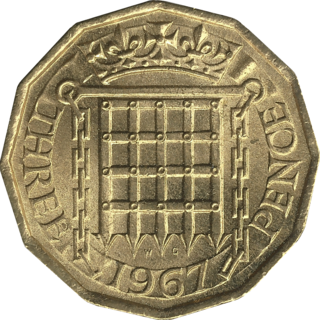
The British threepence piece, usually simply known as a threepence, thruppence, or thruppenny bit, was a denomination of sterling coinage worth 1⁄80 of one pound or 1⁄4 of one shilling. It was used in the United Kingdom, and earlier in Great Britain and England. Similar denominations were later used throughout the British Empire and Commonwealth countries, notably in Australia, New Zealand and South Africa.

The guinea was a coin, minted in Great Britain between 1663 and 1814, that contained approximately one-quarter of an ounce of gold. The name came from the Guinea region in West Africa, from where much of the gold used to make the coins was sourced. It was the first English machine-struck gold coin, originally representing a value of 20 shillings in sterling specie, equal to one pound, but rises in the price of gold relative to silver caused the value of the guinea to increase, at times to as high as thirty shillings. From 1717 to 1816, its value was officially fixed at twenty-one shillings.

The Quarter guinea was a British coin minted only in the years 1718 and 1762. As the name implies, it was valued at one-fourth of a guinea, which at that time was worth twenty-one shillings (£1.05). The quarter guinea therefore was valued at five shillings and threepence in sterling specie.

The crown was a denomination of sterling coinage worth a quarter of one pound. The crown was first issued during the reign of Edward VI, as part of the coinage of the Kingdom of England.

The sovereign is a British gold coin with a nominal value of one pound sterling (£1) and contains 0.2354 troy oz of pure gold. Struck since 1817, it was originally a circulating coin that was accepted in Britain and elsewhere in the world; it is now a bullion coin and is sometimes mounted in jewellery. In addition, circulation strikes and proof examples are often collected for their numismatic value. In most recent years, it has borne the design of Saint George and the Dragon on the reverse; the initials of the designer, Benedetto Pistrucci, are visible to the right of the date.

Benedetto Pistrucci was an Italian gem-engraver, medallist and a coin engraver, probably best known for his Saint George and the Dragon design for the British sovereign coin. Pistrucci was commissioned by the British government to create the large Waterloo Medal, a project which took him thirty years to complete.
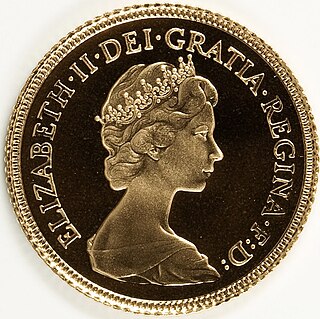
The half sovereign is a British gold coin denominated at one-half of a pound sterling. First issued in its present form in 1817, it has been struck by the Royal Mint in most years since 1980 as a collector's and bullion piece.

Thomas Pingo (1714–1776) was an English medallist and die engraver. He worked for the Royal Mint in London. Originally thought to have come from Italy in 1742, and born there in 1692, he was in fact the son of Thomas Pingo Sr of Plumbtree Court, London. The Pingo family first appeared in London in the 1650s in the Parish of St Martins-in-the-Fields.
The British farthing was a British coin worth a quarter of an old penny. It ceased to be struck after 1956 and was demonetised from 1 January 1961.
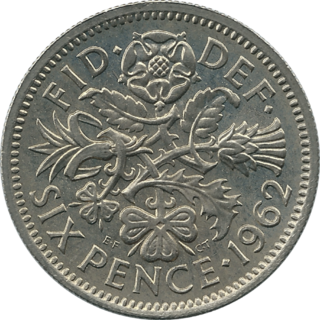
The British sixpence piece, sometimes known as a tanner or sixpenny bit, was a denomination of sterling coinage worth 1⁄40 of one pound or half of one shilling. It was first minted in 1551, during the reign of Edward VI, and circulated until 1980. The coin was made from silver from its introduction in 1551 until 1947, and thereafter in cupronickel.
From c. 1124 until 1709 the coinage of Scotland was unique, and minted locally. A wide variety of coins, such as the plack, bodle, bawbee, dollar and ryal were produced over that time. For trading purposes coins of Northumbria and various other places had been used before that time; and since 1709 those of the Kingdom of Great Britain, and then of the UK.
The threepence or threepenny bit was a denomination of currency used by various jurisdictions in England, Ireland, Scotland and Wales, valued at 1/80 of a pound or 1⁄4 of a shilling until decimalisation of the pound sterling and Irish pound in 1971. It was also used in some parts of the British Empire, notably Australia, New Zealand and South Africa.
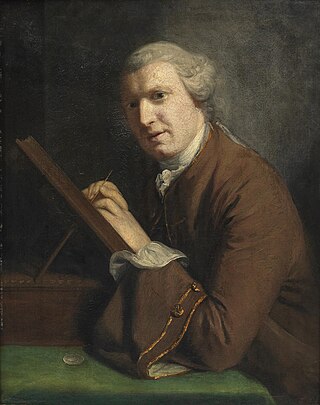
Richard Yeo was a British medalist and Chief Engraver at the Royal Mint, in which capacity he supplied patterns for the guinea and five guinea coins of George III. He was a founding member of the Royal Academy of Art, and appears in the group portrait by John Zoffany.
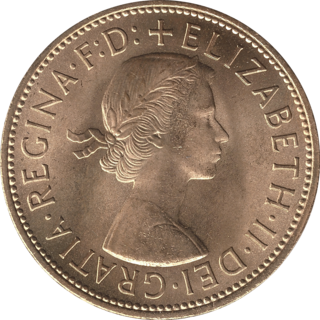
The British pre-decimal penny was a denomination of sterling coinage worth 1⁄240 of one pound or 1⁄12 of one shilling. Its symbol was d, from the Roman denarius. It was a continuation of the earlier English penny, and in Scotland it had the same monetary value as one pre-1707 Scottish shilling. The penny was originally minted in silver, but from the late 18th century it was minted in copper, and then after 1860 in bronze.

Thomas Snelling was an English numismatist.

The Great Recoinage of 1816 was an attempt by the government of the United Kingdom of Great Britain and Ireland to re-stabilise its currency, the pound sterling, after the economic difficulties brought about by the French Revolutionary Wars and the Napoleonic Wars.
Edward Hawkins was an English numismatist and antiquary. For over 30 years he was the Keeper of Antiquities at the British Museum.
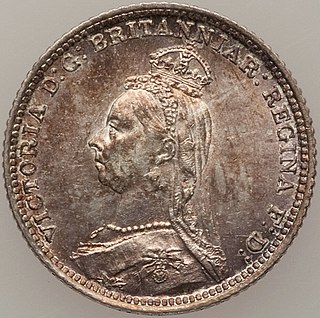
The British fourpence coin, sometimes known as a groat, "joey" or fourpenny bit, is a silver coin worth 1⁄60 of one pound or 1⁄3 of one shilling. It is a continuation of the English groat series struck intermittently from the late 13th century until the Acts of Union in 1707.
This article incorporates text from a publication now in the public domain : Wroth, Warwick William (1896). . In Lee, Sidney (ed.). Dictionary of National Biography . Vol. 45. London: Smith, Elder & Co. pp. 314–315.
{{cite journal}}: Cite journal requires |journal= (help){{cite book}}: CS1 maint: location missing publisher (link){{cite book}}: CS1 maint: location missing publisher (link)